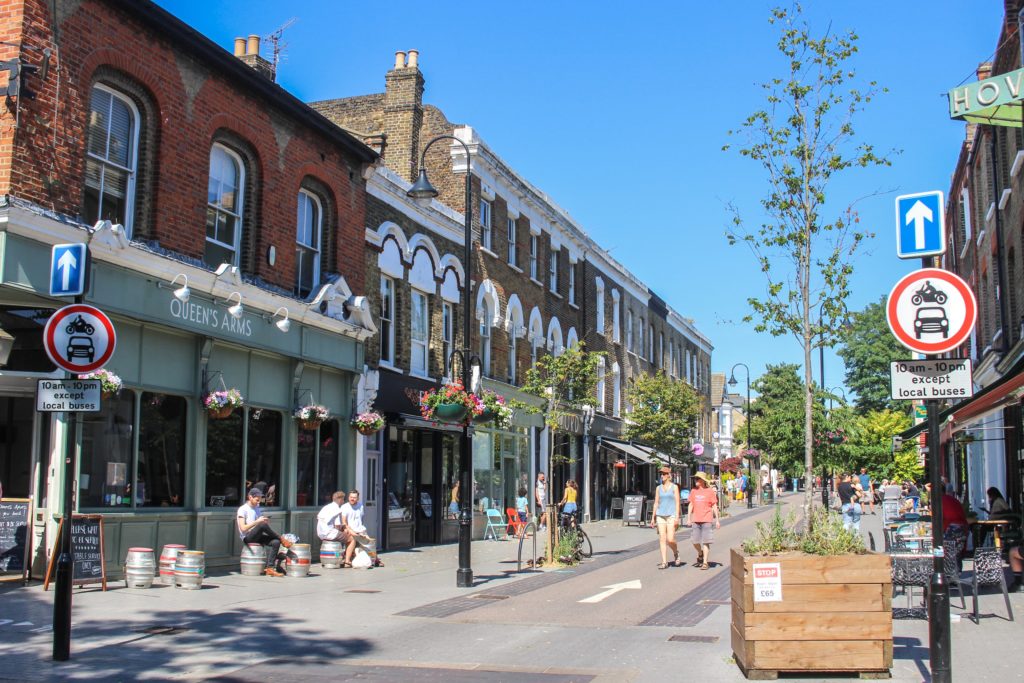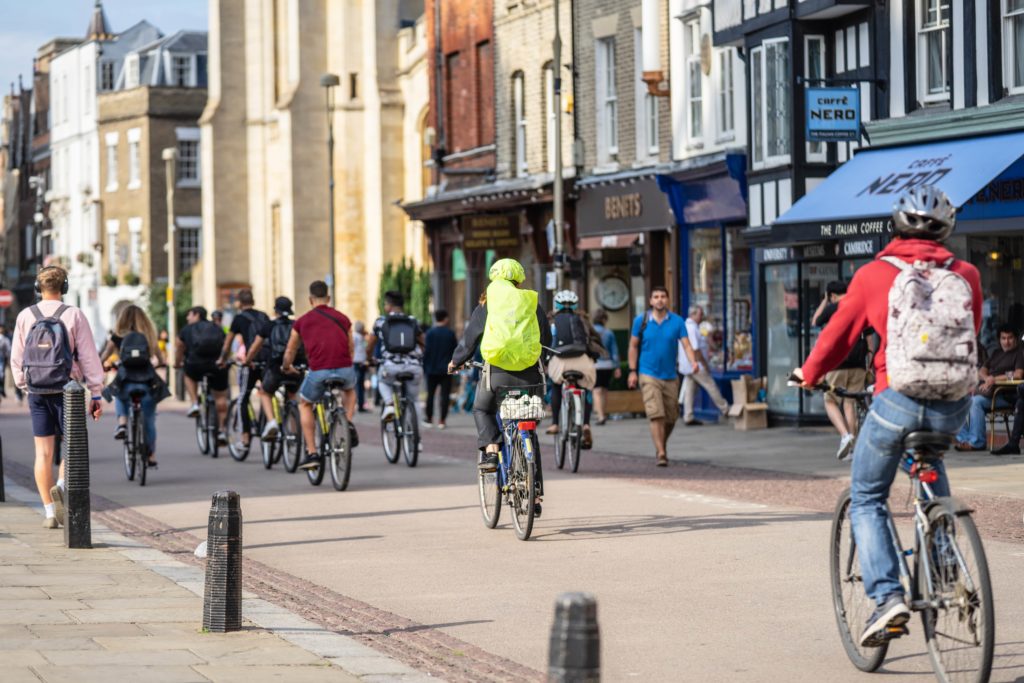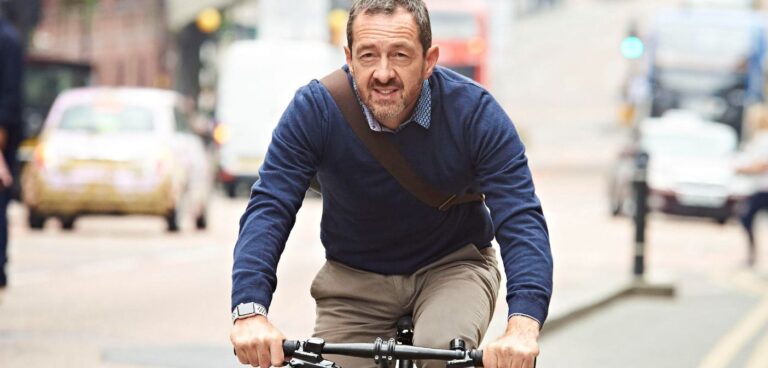When it comes to delivering a new golden age of walking and cycling, Chris Boardman, commissioner of Active Travel England, believes everyone wants what he wants, they just don’t realise it yet. Words by David Smith…
Former Olympic champion cyclist Chris Boardman has been given the task of getting the nation out of their cars and onto their bikes. Boardman will head up a new agency, Active Travel England (ATE) and a £2bn budget to invest in delivering “a new golden age of walking and cycling”. Boardman says his greatest challenges are bringing about cultural change and inspiring political will. Local authorities that want to introduce cycling infrastructure, or close roads off to cars, often have to act in the face of severe opposition from the public and local businesses.
Boardman is a logical choice to head the new agency which will be based in York. He has done a similar job in Manchester for the past few years and his career as a world-class athlete makes him an inspirational figure. However, one of his greatest motivations came not from winning golds but from the crushing sense of disappointment he felt for his daughter a few years ago. Boardman was desperate for her to be able to cycle the 549-metre (1,801ft) ride to the local park in the Northern seaside town they lived in, but felt it wasn’t safe. “It was a big part of my motivation to bring about change. It was just over a decade ago and my daughter was very young. She asked me ‘can we ride to the local park?’ I measured it and I wanted her to do it, but I wasn’t comfortable so I had to say no. And that felt wrong.”
The incident brought it home to Boardman that a lot of the cycling infrastructure in the UK was inadequate. His first opportunity to do something about it came in Greater Manchester where he was appointed Cycling and Walking Commissioner by Mayor Andy Burnham in 2017, then Transport Commissioner in 2021. Boardman and his team began to make significant changes. They introduced an active travel app that integrates different modes of transport and began work on the Bee Network of 1,800 miles of protected walking and cycling routes. But he says there is much work still to be done and expresses frustration that 30% of car journeys in Greater Manchester are less than one kilometre (0.6 miles), a pattern repeated nationwide.
“A lot of it is the school run and for leisure. There’s a lot of resistance to overcome. When you ask parents whether they’re likely to let kids ride to school, you get only around nine percent willing to do so. At the same time, around 96% want their children to do Bikeability cycling raining, which shows they’d like to see their kids out on bikes, they just don’t think it’s safe,” he says. One of the key questions to ask people, he says, is ‘what makes you drive one kilometre even though we’re drowning in evidence of the benefits of cycling?’ “People nearly always say it needs to be easy and it has to feel safe. They say, ‘I want a designated space all the way where I am to where I want to go’. So, ultimately, the main answer is the infrastructure,” he says.
Something of an exception to this general rule, he says, is the city of Cambridge. Boardman says the local authority has achieved great results mainly through prioritising people. The city has the highest level of cycling in the country with one in three residents cycling to work. “There are lots of pedestrianised streets and bus-only streets. And if you go to a college, you’re not allowed to bring the car. But for most towns and cities, creating segregated cycling spaces, including the junctions, will be the critical factor.”
Standards bearer
Boardman was appointed Interim Commissioner for ATE in January and the role became permanent in June. Although it operates within the Department of Transport, the ATE has plenty of autonomy to fulfil the Government mandate. It controls a £2bn budget and sets the criteria for local authorities to receive funding. The ATE’s goal is to enable 50% of all journeys to be made actively by 2030. “Eight years in transport is the blink of an eye, but we expect to see significant returns on investment by 2025. It can happen quite fast. On Oxford Road, in Manchester, we put in a bike lane and within a year we had a 200% increase in cycling,” he says.

The ATE will also carry out Ofsted-style inspections designed to raise standards. And it will offer guidance to councils who want to make changes, but aren’t sure how to go ahead. More than anything, Boardman says his team will be on the lookout for political will. “It’s the most important factor because some of this involves hard choices. It can mean prioritising riding bikes over driving. Councillors might have to take out lanes, or get rid of parking spaces. The greatest lesson of my time in Manchester is that when the political will is not there, it won’t work,” he says.
Although businesses may initially say they support cycling, if it means taking away parking from outside their shops, they may start to panic, he says. “They think they’ll lose money. But in fact, all the studies and statistics say it has quite the opposite effect. People are happy to spend more time and, therefore, spend more money. We do understand the fears. It can be scary when your mortgage is dependent on income. People are often scared of change. But we do a lot of the education around these issues too.”
Local authorities can demonstrate the essential political will by committing to the full programme of changes. Cycling infrastructure will only have the desired effect when there are no gaps. “Another lesson from Greater Manchester was the infrastructure has to be built to a very high standard or we won’t fund it because people won’t use it. So local authorities can’t just do the cycle track, but not the junction. It’s full commitment or no funding,” he says.
Up for the fight
Often, he says, the councillors at local authorities will need courage to fight on in the face of local opposition. But in the long run, evidence shows public opposition will fade away. He points to the example of Clyde Loakes, Deputy Leader of Waltham Forest Council, who faced stiff opposition in 2013 when he proposed to introduce “Mini-Hollands”, or low traffic neighbourhoods (LTNs). Some 41% of residents in the first area where work was planned opposed the plan. A group called E17 Streets for All even took to the courts to stop the plan. They lost and were forced to pay costs.
Boardman says Loakes’ tenacity in continuing to fight for what he believed paid off in the end. There are now 33km (20.5 miles) of segregated cycle lanes in the borough and more than 70 roads are closed to through traffic. Independent shops and bustling cafes have sprung up on roads that used to be rat runs. The 50% of residents who don’t own a car can now travel more safely by bike.
Back in May, when ATE gave councils a round of £250m to promote active travel, LTNs began to spring up around the country. But Boardman says Waltham Forest had already pioneered the idea several years ago and is an example to follow for other local authorities. “It was a tough journey for them and opposition was huge at first at over 40%. But it’s gone down to around two percent of people objecting. People love it as pollution has gone down and bike riding has gone up,” he says. “I like to put Clyde together with councillors from other parts of the country who can see the positive results when you come out the other side. And also, critically for local councillors, the popularity of the individuals who proposed the measures rose significantly. It proved a vote winner in the long run.”
Bike dream
Boardman clearly has a lifelong infatuation with bikes and thinks there is no other activity, or sport, which offers so much to society. “As a kid it was a way for me to extend territory to the next street, then the next. Then it became an activity that linked me with mates, then it was my sport and then my job. Now it’s something to explore again in different ways. I’ll be taking photographs on a bike in the Cairngorms very soon, but it’s also the way I travel to work as I have no car,” he says. More broadly, cycling is able to address every social ill he believes. “This is how we save the NHS, tackle climate change and mitigate the cost-of-living crisis. There is no crisis it doesn’t help to fix. It’s just a means to an end,” he says.

The UK is way behind countries like the Netherlands, where 62% of children ride to school every day and bike traffic jams are not uncommon. But Boardman says even if we’ve a long way to go, we can become “the fastest changing nation”. That requires a big change of mentality, however. And for that reason, he expects a lot of resistance and will initially focus the programme on the few places with a strong desire for change. “We aim to spend all the money with people who have the courage to stand up and fight despite all the noise. And we’ll create inspirational examples. We want to make other local authorities feel very uncomfortable. That will make them want to change.”
Local authorities should learn to look at the long-term consequences of their planning decisions, he argues. If they build a bigger road with a more efficient junction, it will make it really easy to drive and encourage more traffic. But then the junction, he says, becomes inefficient and you need to make it even bigger. “It means taking another perspective and designing the places we want to live. That means nice, sustainable, safe, healthy – the kind of place where you want your kids to grow up.” He says one of the most important questions to ask people protesting against LTNs is ‘are you saying want kids to live in place enabling faster traffic and faster driving?’ “In reality, if we reframe the questions, I think we’ll find everybody wants what I want, they just don’t realise it yet!”
This article was originally published in the September 2022 issue of CiTTi Magazine. Read the original article.





